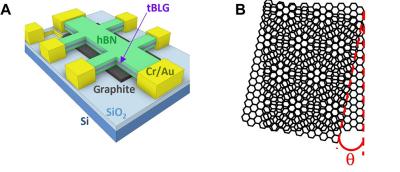Researchers at The Ohio State University, in collaboration with University of Texas, Dallas scientists and the National Institute for Materials Science in Japan, have found that graphene is more likely to become a superconductor than originally thought possible.
 (A) Schematic diagram of device geometry. (B) Schematic diagram of moiré superlattice formed by the twisted graphene layers. Image from Science Advances
(A) Schematic diagram of device geometry. (B) Schematic diagram of moiré superlattice formed by the twisted graphene layers. Image from Science Advances
Graphene by itself can conduct energy, as a normal metal is conductive, but it is only recently that we learned it can also be a superconductor, by making a so-called ‘magic angle’ twisting a second layer of graphene on top of the first, said Jeanie Lau, a professor of physics at Ohio State and co-author of the paper. And that opens possibilities for additional research to see if we can make this material work in the real world.
Graphene, as a single layer, is not a superconductor. However, scientists at the Massachusetts Institute of Technology have published research that showed that graphene could become a superconductor if one piece of graphene were laid on top of another piece and the layers twisted to a specific angle what they termed the magic angle.
That magic angle, scientists thought, was between 1 degree and 1.2 degrees a very precise angle.
The question is, the magic angle, how magic does it have to be? said Emilio Codecido, a graduate student in Lau’s lab and a co-author on the paper.
The Ohio State team found that the magic angle appears to be less magical than originally thought. Their work found that graphene layers still superconducted at a smaller angle, around 0.9 degrees. It is a small distinction, but it could open the possibility of new experiments to investigate graphene as a potential superconductor in the real world. So far, superconducting is limited outside of scientific laboratories because in order to superconduct electricity, the electric lines must be kept at extremely low temperatures.
This research pushed our understanding of superconductors and the magic angle a little further than the theory and prior experiments might have expected, said Marc Bockrath, a co-author of the paper and physics professor at Ohio State.
Superconductivity could revolutionize many industries electric transmission lines, communication lines, transportation, trains, Codecido said. Superconductivity in twisted bilayer graphene will teach us about superconductivity at much higher temperatures, temperatures that will be useful for real-world applications. That’s where future work will be focused.

